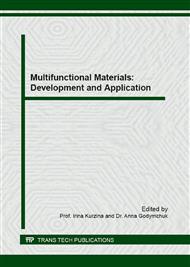[1]
A.K. Mal, S.J. Singh, Deformation of Elastic Solids, Prentice Hall, Englewood, (1991).
Google Scholar
[2]
S.N. Kulkov, S.P. Buyakova, S.V. Panin and P.S. Lyubutin, Formation of surface structures at deformation of porous nonplastic media, Phys. Mesomech [Fizicheskayz Mezomehanica – in Russian]. 9, spec. issue (2006) 83-86.
Google Scholar
[3]
V.V. Kibitkin, A.I. Solodushkin, V.S. Pleshanov, N.V. Chertova, Identification Criteria for Vortex Structures in a Deform Solid, Phys. Mesomech. 17/2 (2014) 141-151.
DOI: 10.1134/s1029959914020064
Google Scholar
[4]
Y. Hirose, Z. Yajima, K. Tanaka, X-ray Fractographic approach to the brittle fracture of ceramics and ceramic composites, in: K. Tanaka, S. Kodama, T. Goto (Eds. ), X-Ray Diffraction Studies on the Deformation and Fracture of Solids, Vol. 10, Elsevier Applied Science London and New York, 1993, p.191.
DOI: 10.1016/b978-0-444-81690-0.50016-9
Google Scholar
[5]
G.D. Quinn, J.J. Swab, and M.J. Slavina, Proposed Standard Practice for Fractographic Analysis of Monolithic Advanced Ceramics, U.S. Army Materials Technology Laboratory, Watertown, Massachusetts, (1991).
DOI: 10.21236/ada231989
Google Scholar
[6]
S.S. Kumar, M. Devaiah, V. Seshu Bai, T. Rajasekharan, Mechanical properties of SiCp/Al2O3 ceramic matrix composites prepared by directed oxidation of an aluminum alloy, Ceram. Int. 38 (2012) 1139–1147.
DOI: 10.1016/j.ceramint.2011.08.042
Google Scholar
[7]
Y.C. Chu, S.I. Rokhlin, G.Y. Baaklini, R.T. Bhatt, Experimental Study of Thermal Oxidation Damage in Ceramic Composites Using Ultrasonic Waves, in: D.O. Thompson and D.E. Chimenti (Eds. ), Review of Progress in Quantitative Nondestructive Evaluation, Vol. 12, Plenum Press, New York, 1993, pp.1421-1428.
DOI: 10.1007/978-1-4615-2848-7_182
Google Scholar
[8]
Senthilkumar , L.J. Baruch , M.F. Luther King, D.G. Oliver, Experimental Studies on Mechanical Properties of Glass Fiber Reinforced Ceramic Matrix Composites, Int. J. of Emerging Tech. and Adv. Eng. 4/6, (2014) 677-681.
Google Scholar
[9]
P.V. Makarov, K.A. Beketov, O.A. Atamanov, S.N. Kulkov, Ductile structural ceramics: modeling the evolution of the structure of mesovolume under mechanical load, in: V.E. Panin (Ed. ), Physical mesomechanics and computer-aided design of materials [Fizicheskayz Mezomehanica i Compujternoe Konstruirovanie Materialov – in Russian], Novosibirsk: Nauka, Siberian publishing firm RAN, Vol. 2, 1995, pp.153-171.
Google Scholar
[10]
V.A. Romanova, R.R. Balokhonov, S. Schmauder, The influence of the reinforcing particle shape and interface strength on the fracture behavior of a metal matrix composite, Acta Mater. 57 (2009) 97-107.
DOI: 10.1016/j.actamat.2008.08.046
Google Scholar
[11]
R.R. Balokhonov, Multiscale analysis of deformation and fracture mechanisms in composite materials, Int. J. of Terraspace Sci. and Eng. 3/1 (2011) 13-37.
Google Scholar
[12]
S.G. Psakhie, E.V. Shilko, A. Yu. Smolin, A.V. Dimaki, A.I. Dmitriev, Ig.S. Konovalenko, S.V. Astafurov and S. Zavshek, Approach to simulation of deformation and fracture of hierarchically organized heterogeneous media, including contrast media, Phys. Mesomech. [Fizicheskayz Mezomehanica – in Russian] 14, 5-6 (2011).
DOI: 10.1016/j.physme.2011.12.003
Google Scholar
[13]
S. Psakhie, E. Shilko, A. Smolin, S. Astafurov, V. Ovcharenko, Development of a Formalism of Movable Cellular Automaton Method for Numerical Modeling of Fracture of Heterogeneous Elastic-Plastic Materials, Fracture and Structural Integrity, 24 (2013).
DOI: 10.3221/igf-esis.24.04
Google Scholar
[14]
S.G. Psakhie, Y. Horie, G.P. Ostermeyer, S. Yu. Korostelev, A. Yu. Smolin, E.V. Shilko, A.I. Dmitriev, S. Blatnik, M. Špegel, S. Zavšek, Movable cellular automata method for simulating materials with mesostructure, Theor. Appl. Fract. Mech. 37/1-3 (2001).
DOI: 10.1016/s0167-8442(01)00079-9
Google Scholar
[15]
Sh. Somiya, Handbook of Advanced Ceramics: Materials, Applications, Processing, and Properties, second ed., Academic Press, New York, (2013).
Google Scholar
[16]
K. K. Chawla, Composite Materials: Science and Engineering, Springer, New York, (1998).
Google Scholar
[17]
R.H.J. Hannink, P.M. Kelly, B.C. Muddle, Transformation toughening in zirconia-containing ceramics, J. Am. Ceram. Soc. 83(3) (2000) 461-487.
DOI: 10.1111/j.1151-2916.2000.tb01221.x
Google Scholar


